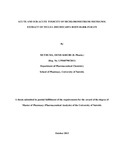| dc.description.abstract | Plant-based medicaments are important therapeutic weapons in the fight against various human
and animal diseases. The current study is based on five plants namely Teclea trichocarpa,
Albizia gummifera, Crotalaria axillaris, Manilkara discolour, and Zanthoxylum usambarense
with more focus on Teclea trichocarpa. Preliminary work has confirmed that these plants
possess anthelmintic activity. Teclea trichocarpa is used as a herbal remedy for malaria
treatment, as an anthelmintic and a vapour inhalant for treatment of fever. Despite the wide
traditional uses of Teclea trichocarpa, its adverse effects or toxicity to human and animals have
not been reported.
The general purpose of the present study was to rapidly evaluate and compare brine shrimp
lethality test of dichloromethane-methanol extracts from different plant parts of Teclea
trichocarpa, Albizia gummifera, Crotalaria axillaris, Manilkara disco 10ur, and Zanthoxylum
usambarense. The results of the brine shrimp lethality test were to be used as the base of
selecting the most active and least investigated extract in terms of toxicity. The specific objective
was to investigate the acute and sub-acute toxicity of the dichloromethane-methanol extract of
the selected extract on Wister rats (Rattus norvegicus).
Plant materials were extracted with dichloromethane-methanol (1: 1 v/v) to obtain the 14 plants
extracts. Viability of brine shrimps eggs was tested and each extracts was evaluated for brine
shrimp lethality test at three concentrations (1000, 100 and 10 mcg/ml) against 10 shrimps. The
mixtures were maintained at room temperature for 24 hour under the light and surviving larvae
were counted. Brine water was used as negative control. For each concentration the test was
carried out in triplicate.
Acute, intraperitoneal and sub-acute toxicity tests were carried out according to the Organization
for Economic Co-operation and Development (OECD) guidelines, starting with the limit test
concentration of 2000 mglkg body weight progressively moving to lower doses. In oral acute
toxicity, Wister rats were fed with the extract at 2000 mg/kg by gavage. During intraperitoneal
acute tests, three sets of rats were each injected with extract at 2000, 300 and 50 mg/kg body
weight and for sub-acute, 3 groups of rats were administered with 1000, 300 and 100 mg/kg
body weight for 28 days. The parameters investigated in the laboratory animals included;
clinical parameters that comprised of skin and fur, eyes, mucous membranes, respiration, the
circulation, autonomic and central nervous systems; haematological tests including haemoglobin
concentration, mean corpuscular haemoglobin, mean corpuscular volume, total erythrocyte
count, haematocrit, and total and differential leucocyte count as well as clinical chemistry
parameters such as total protein, albumin, creatinine and the activities of serum alanine
aminotranferase (AL T) and creatine kinase. Organs from dead or sacrificed rats were first
weighed to determine the OWl and then processed for histopathology as per the standard
protocols.
Out of the 14 extracts, three. from Albizia gummifera pods, Crotalaria axillar is twigs and Teclea
trichocarpa root wood tested using brine shrimps, had LCso>500 and six comprising of Albizia
gummifera root bark, Manilkara discolor root bark and stem bark, Teclea trichocarpa twigs,
stem bark and root had (LC50> 100 < 500 ug /ml). Teclea trichocarpa root bark and
Zanthoxylum usambarense stem bark had LC50 between 30 and 100 ug/rnl. The most active
extracts with LC50 < 30 ug /ml were Albizia gummifera root and Zanthoxylum usambarense root
bark. Teclea trichocarpa root bark extract was selected for the toxicity test since it was among
the most active. Furthermore, no work in terms of its toxicity potential has been found during
literature such as compared Albizia gummifera root and Zanthoxylum usambarense root bark.
During the three days acute oral toxicity testing of dichloromethane-methanol extract of Teclea
trichocarpa root bark, no death occurred at limit dose level of 2000 mg/kg body weight.
Similarly, no death occurred during 28 days sub-acute oral toxicity. During acute intraperitoneal
acute administration of Teclea trichocarpa root bark extract at 2000 mg/kg, all the animals
developed un-coordinated, jerky movement and convulsions followed by death within 3 minutes.
At 300 mg/kg, convulsions were followed by death within 4 to 48 hours but no death occurred at
50 mg/kg. During oral acute, oral sub-acute and 50 mg/kg intraperitoneal tests, notable clinical
signs included transient raised fur and wet feacal droppings. All haematological and clinical
biochemistry parameters fluctuated but remained within normal limits corroborating the absence
of pathological lesions observed grossly and microscopically.
In oral acute and sub-acute study, there was no evidence of extract-induced signs or death at all
the doses of the Teclea trichocarpa root bark extract administered. Lack of death at oral
treatment of 2000 mg/kg body weight and LDso above 2000 mg/kg body weight but below 5000
mg/kg body weight suggests that the Teclea trichocarpa root bark extract is practically nontoxic.
The absence of toxic effects during acute and sub-acute studies support the use of this
plant as a traditional herbal remedy for the treatment of helminthiasis but intraperitoneal
administration of the extract requires further study. | en_US |
| dc.description.department | a
Department of Psychiatry, University of Nairobi, ; bDepartment of Mental Health, School of Medicine,
Moi University, Eldoret, Kenya | |

